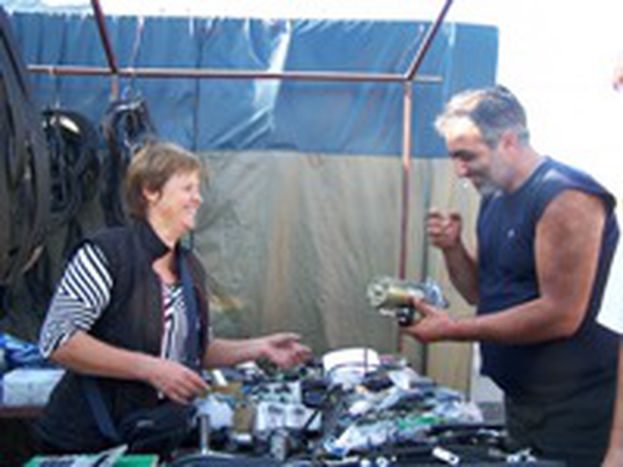
Southern Russia: cracks in the cultural mosaic
Published on
Translation by:
Francesca ReinhardtTrip to Krasnodar, a fragile multi-ethnical paradise in Southern Russia
Three weeks ago, a bomb went off in a luxury Hummer jeep in southern Russia’s Krasnoder, near the border with Georgia. The victim of this still unexplained attack was the owner of a vodka factory, according to the local television stations of the Russian border region.
What the official broadcasters didn’t say was that the victim of the attack, a businessman called Runow, was Georgian. For over a month, the conflict between the former Soviet Union and Georgia, over the apparent espionage scandal, has been escalating, and Georgians living in Russia are collectively suffering the consequences. Runow was involved in Krasnodar’s Centre for Nationalities, on behalf of the Georgian ethnic minority group, Iweria. Shortly after the attack, Russian police turned up at the group’s offices. They went through all the identity papers of the Georgian citizens.
Aggressive nationalism
This was no coincidence. All over Russia, police identified non-registered migrant workers from Georgia and expelled them from the country. Casinos, restaurants, and market stands owned by Georgians were searched and closed. The anti-Georgian campaign is the most recent reflection of President Putin’s support for aggressive nationalism, also directed at the country’s other non-Russian citizens. Residents of the West Russian town of Kondopoga recently went on the rampage, burning and looting and driving out migrant Chechens. More and more foreigners are murdered in Russia. As the NGO "Interethnic Council" (http://www.interethnic.org) reports, have four Non-Russians being murdered in St. Petersburg since the beginning of the year. One of them, the 27 year-old medicine-student Singh Nitesh Kumar died after being attacked with a knife
Two weeks before the attack on the Georgian vodka producer, we met with Krasnoder resident Nagurbek Nagurbekow, chair of the local Tajik immigrant community. “Events like those in Kondopoga would be unthinkable here,” he assured us. Krasnodar is different to the rest of Russia. A hundred and twenty-six nationalities live together peacefully here – a multicultural paradise. People intermarry regardless of language or cultural differences, black and Arab students live undisturbed, and “there aren’t any Fascists here, and there won’t be any either.” Nagurbekow has never experienced any kind of interethnic conflict.
Ethnic pluralism is the norm
Krasnodar is a microcosm of Russia: 86% of the population is Russian, however there are also Armenians, Georgians, other peoples from the Caucuses, Central Asia, and Eastern Europe. After Moscow, it is the fastest growing region of Russia. Following the breakup of the Soviet Union, the population grew from four to five million. Many of the new arrivals were sun-seeking Russians, appreciative of the Mediterranean climate and excellent beaches on the Black Sea. Others came from former Soviet Republics, such as Tajikistan and Georgia. Even now they benefit from the generous naturalization laws.
A high rate of immigration does not necessarily lead to more conflict. Wladimir Petrow totally agrees with Nagurbekow, the Tajik, on this point. Petrow is director of the Sociology Department at the University of Krasnodar and for many years has researched with his colleagues how the inhabitants of the region live together. The majority of people are long used to ethnic pluralism and know how to work with it, he says. Another factor is the clever policy of the local government in the 1990s. Since then, city and regional officials consult representatives from minority groups on all important political questions. The government sponsored Centre for Nationalities offers language courses, newcomer integration help, as well as classes on ethnic dances and folklore.
Petrow and Nagurbekow are clear on this issue: Krasnodar is a model example of flourishing integration. And then, a car bomb explodes the cultural mosaic and exposes it as mere wishful thinking.
Swastikas on the wall
Stasja Denisova has warned others about this for years. The twenty-three year old works for the NGO Etnika against racial hatred. She reports that Krasnodar has skinheads just like the rest of Russia. They paint swastikas on walls and do paramilitary training in the back yards of housing projects. In July, a Sudanese student was knocked over by shaven-headed Russians in front of his residence, and so badly beaten that he spent a month in a coma. Denisova says that the 1,500 students from Sudan and the Middle East only go out between the residences, the university, and the supermarket, out of fear.
Along with other people from Etnika, she is always alerting municipal authorities to such problems. The response: “Taking action against skinheads will only start racial hatred problems.” Krasnodar authorities still want to believe in a city that is different from warring Chechnya, only a few hundred kilometers away, different from northern Russian towns, where Fascism is an accepted fashion among the young. Now maybe this unfortunate attack on a Georgian will finally force the powers that be to open their eyes and speak out.
Translated from Südrussland: Kratzer im Multi-Kulti-Ideal



